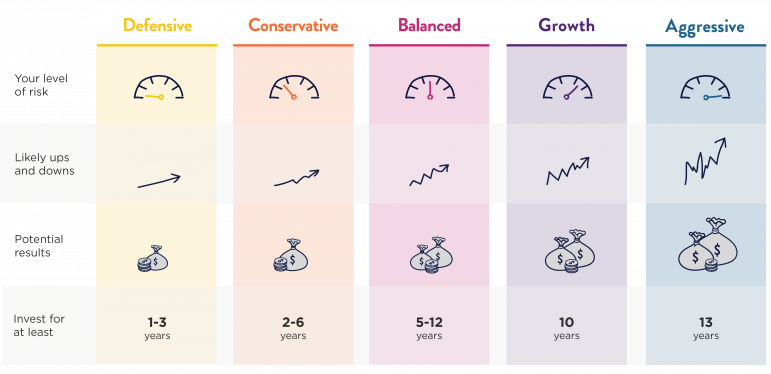
27 April 2021
Reading time: 7 minutes

Your KiwiSaver grows quietly behind the scenes. With a little bit of care and attention to your settings, it can be life changing, helping you get into your first home and live your best life when it’s time to retire. Here are some cool facts about our retirement savings and investment scheme – KiwiSaver.
Despite the name, your KiwiSaver isn't just a savings account. When you put money into your KiwiSaver account, it doesn't just sit there – it’s invested on your behalf.
Your KiwiSaver provider invests your money into a huge range of companies, property, bonds and cash. So instead of having to research and decide where every dollar is invested, you just choose the right fund for you, and your provider does the rest.
There are loads of other people investing in the same fund as you, so your fund provider can invest in thousands of different companies and products. This is called a managed fund – it’s managed for you, so you can spend your time on other important things.
It means that not only are you growing your money by paying into your KiwiSaver every pay, but your money is also making money when your investments grow in value – increasing your returns and your future choices.
KiwiSaver funds come in five types, based on the mix of investments they hold.

Deciding which one is best for you depends on how long you are investing for and your attitude towards risk. Changing to the right type of fund for your situation means by the time you retire, your KiwiSaver balance could be many thousands of dollars higher.
Let’s say over your entire career you earn an average of $60,000 a year – being in a growth fund (if it’s a good fit) instead of a conservative one could give you $133,000 more.* And even if that's not your situation, switching to the right fund for you can make many thousands of difference.
If you want to find out where your money is invested, you can find your fund on Smart Investor and check out the ‘investment mix’. This gives you a breakdown of the types of investments (assets) that the fund is invested in. You can see the top 10 investments, or if you’re super curious, you can download a list of every investment your fund holds.
If you’re keen to check out if your money is invested in things that align with your ethical values, head to Mindful Money.
You get to choose what type of fund it’s invested in – we recommend this is based on your goals, how much time you have until you want to use it, and your appetite for risk.
After you turn 65, you can withdraw all of your KiwiSaver money to use it how you want, keep it invested, organise a regular payout – whatever suits your situation.
There are some reasons you may be able to withdraw money from your KiwiSaver before you retire – for a first-home deposit, or if you have a relationship breakdown, are diagnosed with a terminal illness, or have fallen on hard times and can’t cover your everyday expenses.
Everyone needs to choose which fund to be in, so which is the best fund for you? It's important to pick your fund based on important criteria (not just because it's a familiar brand or something). If you didn’t actively choose a fund when you started in KiwiSaver, you were set up in a ‘default’ fund. This was to get you started, until you got around to making a choice yourself, so it’s not a good plan to just leave it there!
But how do you pick one? First up is to find out which type of fund is right for you!
Your KiwiSaver money is held in a trust. That means that the funds are held separately – no one can touch them.
If a KiwiSaver provider’s business were to get into trouble financially, your money would be protected. Your investments would not be affected, even though the provider’s own business could suffer.
You’d still be on track to reach your goals.
As a KiwiSaver member, your employer adds at least 3% of your salary to your KiwiSaver – typically on top of your pay – and some employers choose to put in more. It's taxed before it goes into your KiwiSaver, so it’s typically slightly less than 3%. (Note: this will be lifting from 3% to 3.5% in April 2026, and 4% in April 2028.)
If you’re not currently employed, or you’re working for yourself, you can still get extra money put into your KiwiSaver every year from the government.
Getting the full government contribution to your KiwiSaver each year takes just $20 a week. For every dollar you put in, the government will match it with 25 cents, up to a maximum of $260 for you. That’s every year, whether you’re working or not.
And even if you can only put in $10 or $5, the government will match that in the same way. It’s the closest thing to free money that we know of!
Saving a first home deposit is a great goal – and your KiwiSaver can help you get there faster. There are couple of things to remember. Firstly, you will have to be a KiwiSaver member for more than three years. Secondly, when it comes time to withdraw, make sure you allow plenty of time to get in touch with your provider to take care of the paperwork – it can take a couple of weeks to process!
When you put money into KiwiSaver, you’re buying units in a managed fund. (The only time the number of units you own will go down is if you withdraw money – selling those units to use the money for your first home, or to use after you turn 65.)
Your units are parts of many different investments. Some investments will do well, others not so much. So the value of your units will go up and down depending on how much they’re worth at a given time, but the number of units you own only grows as you, your employer and the government pay into your KiwiSaver.
KiwiSaver is your money. It’s as real as the money in your savings account, and just as much yours. Head to step 2 of our ‘6 steps to get Sorted’ to make sure you’re making the most of KiwiSaver.
* The projections shown here are for an employee earning an average of $60,000 over a career of 47 years, from age 18 to 65. All figures here have been adjusted for inflation of 2%, and have also been rounded to the nearest $1,000. We’ve assumed returns after tax and fees of 2.5% p.a. in a conservative fund and 4.5% p.a. in a growth fund for someone with a 28% PIR.
Use verification code from your authenticator app. How to use authenticator apps.
Don't have an account? Sign up
Or log in with our social media platforms


A free account gives you your very own space where you can save your tools and track your progress as you get ahead.
Or sign up using Google:


Comments (6)
Comments
20 October 25
Tom from Sorted
Thanks David, the government's contribution of up to $260 is paid after the KiwiSaver financial year ends at the end of June each year. You can expect to see it in early July, essentially.
19 October 25
David
When is the government contribution put into my account please?
17 August 21
Anonymous
Are there benefits/disadvantages of splitting Kiwisaver investments into 2 classes within a fund, such as half in Balanced and half in Growth? In times of uneven growth between the different classes, units would have to be frequently sold in order to maintain the 50/50 balance of investment within each class. Would this have a negative effect on the performance of the overall total investment over time, and incur additional fees? Is it better to just invest in a single class?
15 May 21
Tim Hickey
Facts 2 and 7 are not quite complete.
In Fact 2, "Choosing the right fund can make a $100,000 difference" should say, "Choosing a fund with higher expected average returns can have a surprisingly large effect on your future KiwiSaver balance."
The difference is not limited to $100,000; it could be any non-negative amount.
13 May 21
Tom from Sorted
Thanks for commenting. Remember that when you contribute to KiwiSaver, you are putting in post-tax dollars (typically income that has already been taxed), so there has never been a limit as to how much you can contribute each year, which can happen overseas. KiwiSaver does not have tax advantages in particular, but you are not taxed when you withdraw, either.
4 May 21
Anonymous
Hi I am a Kiwi and currently living overseas and unemployed. I want to put more money into my KiwiSaver for investment. What is the maximum amount that I can make as a contribution each year?
Many thanks and regards
No one has commented on this page yet.
RSS feed for comments on this page | RSS feed for all comments